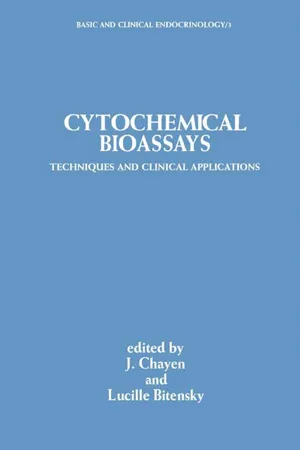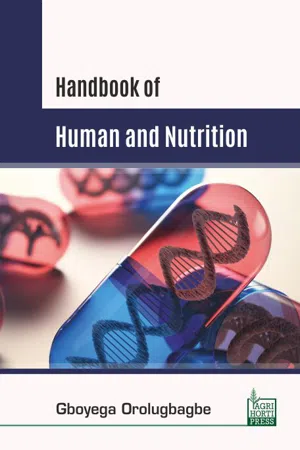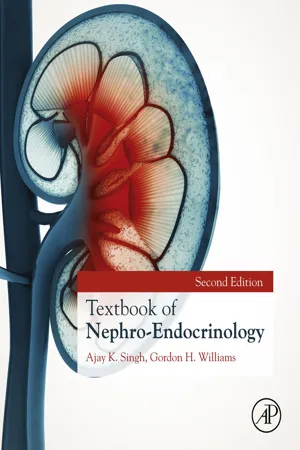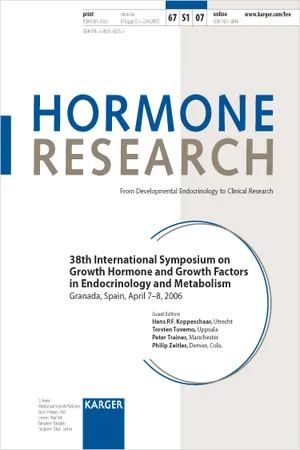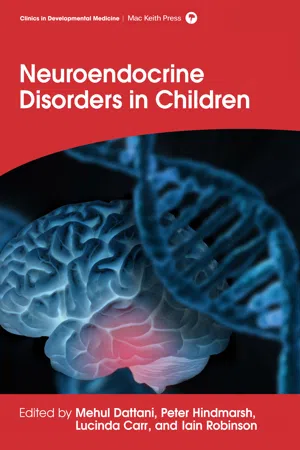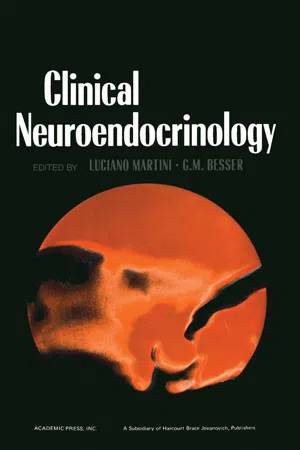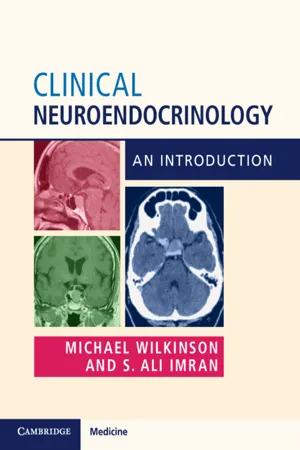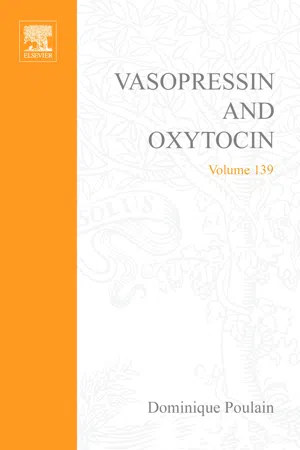Biological Sciences
Antidiuretic Hormone (ADH)
Antidiuretic Hormone (ADH) is a hormone produced by the hypothalamus and released by the pituitary gland. It plays a key role in regulating the body's water balance by controlling the amount of water reabsorbed by the kidneys. ADH helps to reduce the amount of urine produced by the body, thereby conserving water and preventing dehydration.
Written by Perlego with AI-assistance
Related key terms
1 of 5
10 Key excerpts on "Antidiuretic Hormone (ADH)"
- eBook - ePub
Endocrine Problems in Cancer
Molecular Basis and Clinical Management
- Roland T. Jung, Karol Sikora, Roland T. Jung, Karol Sikora(Authors)
- 2013(Publication Date)
- Butterworth-Heinemann(Publisher)
Chapter 9Disorders of Vasopressin Function
Peter H. BaylisPublisher Summary
This chapter reviews the recent developments, information, and ideas on vasopressin function in disturbances of water regulation associated with tumors. It also discusses the most appropriate diagnostic methods and management of patients suffering from cranial diabetes insipidus and the syndrome of inappropriate antidiuresis. Arginine vasopressin is an antidiuretic hormone that helps to regulate water balance in most mammalian species. It is synthesized in the magnocellular neurons of the supraoptic and paraventricular nuclei in the hypothalamus. The hormone is transported as a vasopressin precursor–neurophysin complex in neurosecretory granules along nerve axons to at least four distinct areas of the brain. Plasma tonicity controls the vasopressin secretion. Although increasing plasma osmolality by hypertonic infusion causes a progressive linear rise in plasma vasopressin, the antidiuretic activity of vasopressin does not continue to increase above plasma vasopressin concentrations of about 5 pmol/liter. Blood pressure and blood volume are two major factors that influence vasopressin secretion. The sensitized measuring of circulating vasopressin defines malignant disease disorders.INTRODUCTION
The antidiuretic hormone in man and most mammalian species is arginine vasopressin, and it is well established that this hormone plays an important role in regulating water balance. Until a decade ago, it had proved difficult to define precisely the normal physiology of water regulation because the experimental methods were poor. In particular, the measurement of vasopressin in body fluids was very troublesome. But within the last few years, radioimmunoassay methodology has improved sufficiently to provide sensitive and specific methods capable of detecting the extremely low concentrations of vasopressin that circulate in blood under normal physiological conditions. Although numerous assays for the measurement of plasma arginine vasopressin have been described, it must be emphasised that these assays remain difficult to perform, are capricious and liable to non-specific interference, and the majority require extraction of vasopressin from plasma prior to assay. - eBook - PDF
- Elizabeth H. Holt, Harry E. Peery(Authors)
- 2003(Publication Date)
- Academic Press(Publisher)
ADH is also called arginine vasopressin, in reference to the acute increase in blood pressure seen as a result of arteriolar constriction produced when the hormone is administered in sufficient dosage.Antidiuretic effects are seen at lower hormone concentrations, as compared to vasoconstrictor effects. The two actions of the hormone are produced by two different G-protein-coupled receptors.The V1 receptor is coupled through G α q βγ to phospholipase B and therefore signals through the diacylglycerol/inositol trisphosphate second messenger system (see Chapter 1) and produces its vasopres-sor effect by constricting vascular smooth muscle. The antidiuretic effect is produced by the V2 receptor, which signals through G α s βγ to activate adenylyl cyclase and cyclic AMP production in renal tubular cells. Antidiuretic Hormone 227 A NTIDIURETIC E FFECT Osmolarity of blood plasma can be increased or decreased by adjusting the proportion of water relative to solute that is excreted in the urine, thus producing reciprocal changes in the osmolality of the urine. Water that is reabsorbed or excreted in excess of solute is referred to as free water . Conservation of free water lowers, and excretion of free water raises, plasma osmolality.As already mentioned, 228 Chapter 7. Regulation of Sodium and Water Balance Na + Na + Na + Na + Na + Na + H 2 O H 2 O H 2 O descending limb thin ascending limb thick ascending limb interstitium Figure 3 The countercurrent multiplier in the loop of Henle. Selective permeability of the tubular epithelium and active transport of sodium by the thick ascending limb create osmotic gradients.Tubular to interstitial flow of water concentrates sodium (shown in blue) in the descending limb. Sodium move-ment across the water-impermeable ascending limb creates the osmotic gradient in the interstitium. - eBook - ePub
Cytochemical Bioassays
Techniques and Clinical Applications
- J Chayen, Lucille Bitensky(Authors)
- 2013(Publication Date)
- Butterworth-Heinemann(Publisher)
As life emerged from the primordial seas, the need to maintain constancy of tissue composition necessitated the development of homeostatic mechanisms. Conservation and regulation of body water was critical for survival on land, and so evolved antidiuretic hormones which are the principal regulators of water excretion for animals. Arginine vasopressin is the antidiuretic hormone for most mammals, including humans.Although the concept of constancy of the internal medium had been proposed in the mid-nineteenth century by Claude Bernard (1865) , a factor controlling renal water excretion was not discovered until early in the next century. A pressor function was originally ascribed to extracts from the pituitary gland (Oliver and Schäfer, 1895 ), but by 1901, Magnus and Schäfer had observed oliguria in dogs injected with small extracts from the posterior lobe of the pituitary. Mechanical destruction of the gland resulted in profound polyuria (Schäfer 1909 ). The precise work of Starling and Verney (1924) demonstrated clearly the antidiuretic effect of posterior pituitary extracts on the isolated kidney, and so a water-regulating factor had been discovered. Over the subsequent decades the mechanisms which control the secretion of this factor, antidiuretic hormone, were elucidated. Changes in blood tonicity appeared to be a major determinant of the release of antidiuretic hormone, mediated by specialized intracranial cells sensitive to osmotic change (Verney, 1947 ). These observations indicated that a true homeostatic mechanism maintaining constant body water did exist. It is now realized that nonosmotic stimuli may also be important in controlling the secretion of this hormone (Scheiner, 1975 ).The physiology of the hormone will be briefly discussed before concentrating in the assay methods available to measure antidiuretic hormone in body fluids, particularly in plasma, and describing the technique, validation, and limitations of a cytochemical bioassay to detect this hormone.PHYSIOLOGY OF ANTIDIURETIC HORMONE
Chemistry
Arginine vasopressin (AVP), the major mammalian antidiuretic hormone, is a nonapeptide with a molecular weight of 1084. Because three carboxyl groups are amidated it is strongly basic (isoelectric point pH 10.9). Its chemical structure is given in Figure 1 . Lysine vasopressin is the other antidiuretic hormone but is confined to Suidae (members of the pig family). The structure of AVP was elucidated by Acher and Chauvet (1954) , and the molecule was synthesized in 1958 by du Vigneaud’s group. Apart from vasopressin, mammals synthesize a second nonapeptide, oxytocin, the structure of which is similar to the vasopressins but it has no antidiuretic action. Closely related peptides (e.g., vasotocin) are formed in reptiles and birds, and an interesting evolutionary sequence from an ancestral molecule has been postulated by Acher (1974) . More recently investigations have concentrated on the relationship between tertiary structures of antidiuretic hormone and its biological function (Forsling, 1979 - eBook - PDF
- Orolugbagbe, Gboyega(Authors)
- 2018(Publication Date)
- Agri Horti Press(Publisher)
High levels of antidiuretic hormone decrease water excretion by the kidneys. The pituitary gland produces and releases antidiuretic hormone when the blood volume or blood pressure go down or when levels of electrolytes become too high. This ebook is exclusively for this university only. Cannot be resold/distributed. Minerals 259 Pain, stress, exercise, a low blood sugar level, and certain disorders of the heart, thyroid gland, kidneys, or adrenal glands can stimulate the release of antidiuretic hormone from the pituitary gland, as can the following drugs: • Chlorpropamide (which lowers the blood sugar level) • Carbamazepine (an anticonvulsant) • Vincristine (a chemotherapy drug) • Clofibrate (which lowers cholesterol levels) • Antipsychotic drugs • Aspirin, ibuprofen, and many other nonprescription pain relievers (analgesics) • Vasopressin (synthetic antidiuretic hormone) and oxytocin (both drugs help the body conserve fluids) Secretion of antidiuretic hormone is termed inappropriate if it occurs even though blood volume and blood pressure are normal or high, electrolyte concentrations are low, and other triggers of ADH release are not present. When antidiuretic hormone is released in these situations, the sodium level in blood decreases, and the body retains too much fluid. SIADH is common among older people and is fairly common among people who are hospitalized. Many conditions increase the risk of developing SIADH. SIADH may result when antidiuretic hormone is produced outside the pituitary gland, as occurs in some lung and other cancers. Symptoms of SIADH tend to be those of the low sodium level in blood (hyponatremia) that accompanies it. Diagnosis and Treatment Doctors suspect SIADH based on a person’s circumstances and symptoms. Blood and urine tests are done to measure the sodium and potassium levels and to determine how concentrated the blood and urine are (osmolality). - eBook - ePub
- Ajay K. Singh, Gordon H. Williams(Authors)
- 2017(Publication Date)
- Academic Press(Publisher)
Chapter 5Vasopressin in the Kidney—Historical Aspects
Lynn E. Schlanger1 , 2 , and Jeff M. Sands21 Atlanta Veterans Affairs Medical Center, Atlanta, GA, United States2 Emory University, Atlanta, GA, United StatesAbstract
In the past century, scientific research has made great strides and has unraveled the pathophysiology for water homeostasis and its dysregulation in certain disease processes such as nephrogenic diabetes insipidus and hyponatremia. In the mid-20th century, experimental infusion of a pituitary gland extract was noted to cause antidiuresis and concentrated urine leading to the discovery of the antidiuretic hormone, ADH. The ADH was found to be produced in the hypothalamus neurons and stored and secreted by the pituitary gland and resulting in a downstream effect on the “shuttling” of water channels to luminal surface in the toad bladder and in the collecting duct. In the latter half of the 20th century with advancements in molecular biology and immunohistochemistry, vasopressin receptors, urea transporters, and aquaporins (water channels) were identified as well as their various roles in water homeostasis. The V2 (vasopressin) receptor was isolated in the distal nephron tubules and determined to be responsible for water balance while V1a and V1b receptors were not. Similarly, two of the six isoforms of urea transporters, UT-A1 and UT-A3, were localized in the inner medullary collecting ducts; both of these are stimulated by vasopressin and have an important role in maintenance of the countercurrent system. Of the 13 aquaporins identified, 3 were localized in the collecting ducts; aquaporin 2, 3, and 4, with only aquaporin 2 regulated by vasopressin and “shuttled” to luminal membrane. These various discoveries, translating from bench research to clinical studies, have given us the opportunity to treat various disease states such as chronic hyponatremia, adult polycystic kidney disease, central diabetes insipidus, and genetic and acquired nephrogenic diabetes insipidus. - eBook - PDF
Growth Hormone and Growth Factors in Endocrinology and Metabolism
38th International Symposium, Granada, April 2006. Supplement Issue: Hormone Research 2007, Vol. 67, Suppl. 1
- Koppeschaar, Tuvemo, Trainer, Zeitler(Authors)
- 2007(Publication Date)
- S. Karger(Publisher)
The practical clinical importance of each point is explained after its presentation. Interested readers are referred to several excellent comprehensive reviews that cover all aspects of body water homeostasis for additional details [1–5]. Point #1: The entire AVP-stimulated signal transduc-tion pathway is necessary for AVP-mediated antidiuresis. The prime determinant of free water excretion in animals and man is the regulation of urine flow by circulating levels of AVP in plasma, also known as antidiuretic hor-mone (ADH). AVP is a nine-amino acid peptide that is synthesized in specialized (magnocellular) neural cells located in the supraoptic and paraventricular nuclei of the hypothalamus. The synthesized peptide is enzymati-cally cleaved from its prohormone as it is transported to the posterior pituitary gland, where it is stored within neurosecretory granules until specific stimuli cause se-cretion of AVP into the bloodstream [3]. Antidiuresis then occurs via interaction of the hormone with its V 2 -type receptors (V2R) in the kidney. Binding of AVP to V2R activates the Gs adenylyl cyclase system, increasing intracellular levels of cyclic adenosine monophosphate (cAMP). The cAMP activates protein kinase A, which in turn phosphorylates preformed aquaporin-2 (AQP2) wa-ter channels localized in intracellular vesicles of collect-ing duct epithelial cells. Phosphorylation promotes traf-ficking of the vesicles to the apical membrane, which is followed by insertion of AQP2 into the apical cell mem-branes. This is the rate-limiting step that renders the col-lecting duct permeable to water. AQP2 membrane inser-tion, and transcription, are reduced when AVP is either absent or chronically suppressed [6]. The clinical importance of this point is that any defect in the renal AVP-signaling system can lead to pathologi-cal inability to conserve body water. - eBook - PDF
- Mehul Dattani, Peter Hindmarsh, Lucinda Carr, Iain C A F Robinson(Authors)
- 2016(Publication Date)
- Mac Keith Press(Publisher)
55 5 NEUROENDOCRINE DISORDERS OF SALT AND WATER BALANCE Joseph A Majzoub Introduction Paediatric neuroendocrine disorders of salt and water balance are uncommon but important causes of morbidity and mortality. Most often they either arise independently from genetic or neoplastic causes, or occur subsequent to accidental or surgical trauma (Maghnie et al. 2000). This chapter focuses upon genetic causes, but notes other aetiologies for complete-ness. In most patients with central diabetes insipidus, a definitive diagnosis can eventually be made (Di lorgi et al. 2014), either upon initial presentation following a comprehensive evaluation (in ~28% of cases), or after continued evaluation over many years (in ~96% of cases). It is therefore useful to understand the pathophysiology and differential diagnosis of central diabetes insipidus in children. Physiology of water balance The posterior pituitary, or the neurohypophysis, secretes the nonapeptide hormone argi-nine vasopressin (AVP), also known as antidiuretic hormone (ADH). Vasopressin controls water homeostasis, and disorders of vasopressin secretion and action lead to clinically important derangements in water metabolism. Osmotic sensor and effector pathways control the regulation of vasopressin release, whereas volume homeostasis is determined largely through the action of the renin–angiotensin–aldosterone system, with contribu-tions from both vasopressin and the natriuretic peptide family. The human vasopressin gene consists of three exons. The first exon encodes the 19-amino-acid signal peptide, followed by the vasopressin nonapeptide, which is followed by a 3-amino-acid protease cleavage site leading into the first nine amino acids of neurophysin II. After interruption of the coding region by an intron, the second exon continues with neurophysin coding sequences. - eBook - PDF
- Luciano Martini(Author)
- 2012(Publication Date)
- Academic Press(Publisher)
Chapter 22 Vasopressin C. R. W. Edwards I. Introduction 527 Π. Nature 528 A. Chemistry 528 B. Biosynthesis 528 C. Assay Methods 530 D. Metabolism 532 ΠΙ. Control Mechanisms 535 IV. Neurotransmitters 539 V. Effects 541 A. Antidiuretic Action 541 B. Effect on Electrolyte Transport 542 C. Pressor Action 542 D. Effects on Release of Anterior Pituitary Hormones 543 E. Central Effects on Memory and Learning Processes 544 VI. Drug Interactions 545 VII. Pathophysiology 548 A. Diabetes Insipidus 548 B. Syndrome of Inappropriate Secretion of Antidiuretic Hormone... 555 VIII. Conclusions 560 References 560 I. INTRODUCTION The recent introduction of more sensitive and specific assays for vasopressin has allowed a more critical evaluation of both the physiology and pathophysiol-ogy of vasopressin release. Hopefully, the application of these assays will lead to a gradual replacement of the indirect methods used for assessing posterior pituit-ary function. Already it is becoming clear that vasopressin has many effects other than its classic antidiuretic action; it may, for example, play an important role in 527 528 C. R. W. Edwards memory and possibly other learning processes. Many drugs have now been found that affect neurohypophyseal function and this has led to dramatic advances in the treatment of diabetes insipidus. Equally important has been the advance in understanding the role of excessive vasopressin secretion in many diseases. This chapter will attempt to highlight some of these important advances. II. NATURE A. Chemistry Arginine vasopressin (AVP) is the major mammalian antidiuretic hormone and is the vasopressin secreted by the neurohypophysis in man. The amino acid sequence of the molecule was first determined by Turner et al. (1951) using material isolated from bovine posterior pituitary glands (Fig. 1). - eBook - PDF
Clinical Neuroendocrinology
An Introduction
- Michael Wilkinson, S. Ali Imran(Authors)
- 2019(Publication Date)
- Cambridge University Press(Publisher)
The elevation in VP concentration stimulates renal water resorption via the collecting ducts, thereby diluting plasma and reducing osmolality. Conversely, an oral water load will reduce plasma osmolality and suppress VP secretion. Healthy indi- viduals maintain plasma osmolality within the range 282–295 mOsmol/kg, a threshold above which VP increases are observed (Figure 9.6). The antidiuretic effect of VP in the kidney is mediated by G protein-coupled V2R. Binding of VP to V2R stimulates the adenyl cyclase/cAMP/protein kinase A pathway to activate (phosphorylate) the aquaporin 2 water channel protein (AQP2), which is then transported to the luminal surface of the collect- ing duct. The AQP2 channels permit recovery of water from urine, and additional aquaporins (AQP3 and 4) complete the water reabsorption process (Babey et al., 2011). Figure 9.7 illustrates the sequence of events by which VP regulates water recovery (anti- diuresis) from urine. 9.7 Disorders of VP Secretion Diabetes Insipidus The critical role of VP in maintaining fluid balance is revealed when the production or action of VP is compromised. For example, an inability to facilitate reabsorption of water has several clinical conse- quences: dilute urine output is increased (polyuria; >3 L/24 hours), producing hyperosmolar plasma and intense thirst that stimulates an increase in fluid intake (polydipsia). This condition is known as dia- betes insipidus (DI). Unlike diabetes mellitus, which is associated with glycosuria, the urine in DI is bland or insipid. DI may either be due to a deficient release of VP from the posterior pituitary – called hypotha- lamic or central DI (HDI; also called neurohypophy- seal or pituitary DI) – or to a reduced effect of VP on the renal VP receptors (nephrogenic DI; NDI). - D. Poulain, S. Oliet, D. Theodosis(Authors)
- 2002(Publication Date)
- Elsevier Science(Publisher)
D. Poulain, S. Oliet and D. Theodosis (Eds.) Progress in Brain Research , Vol. 139 © 2002 Elsevier Science B.V. All rights reserved CHAPTER 25 Oxytocin, vasopressin and atrial natriuretic peptide control body fluid homeostasis by action on their receptors in brain, cardiovascular system and kidney Samuel M. McCann 1, ∗ , José Antunes-Rodrigues 2 , Marek Jankowski 3 and Jolanta Gutkowska 3 1 Pennington Biomedical Research Center (LSU), 6400 Perkins Road, Baton Rouge, LA 70808-4124, USA 2 Department of Physiology, School of Medicine, University of Sao Paulo, 14049 Ribeirao Preto, Sao Paulo, S.P., Brazil 3 Laboratory of Cardiovascular Biochemistry, Research Centre, CHUM – Hôtel-Dieu, 3850 St. Urbain Street, Masson Pavilion, Montreal, QC H2W 1T7, Canada Keywords: Vasopressin; Angiotensin II; Baroreceptors; Hypothalamus; Anterior ventral third ventricle; Nitric oxide synthase; Guanylyl cyclase; Cyclic guanosine monophosphate Introduction Clinical studies involving patients with diabetes in-sipidus and the description of cases with brain le-sions which had either hypo-or hypernatremia sug-gested an important role for the hypothalamus in the control of water and salt intake and excretion. In the early fifties, Andersson and McCann showed that mi-croinjection of minute quantities of hypertonic saline (0.002 μ l) into the hypothalamus of goats could induce drinking (Andersson and McCann, 1955a). Since the effect was only repeatable 2–3 times, perhaps because of damage to the tissue by the hypertonic solution, electrical stimulation of the hy-pothalamus was performed (Andersson and McCann, 1955b). Electrical stimulation in the same region which evoked drinking following injection of hyper-tonic saline, caused reproducible drinking with very ∗ Correspondence to: S.M. McCann, Pennington Biomed-ical Research Center (LSU), 6400 Perkins Road, Baton Rouge, LA 70808-4124, USA.
Index pages curate the most relevant extracts from our library of academic textbooks. They’ve been created using an in-house natural language model (NLM), each adding context and meaning to key research topics.


